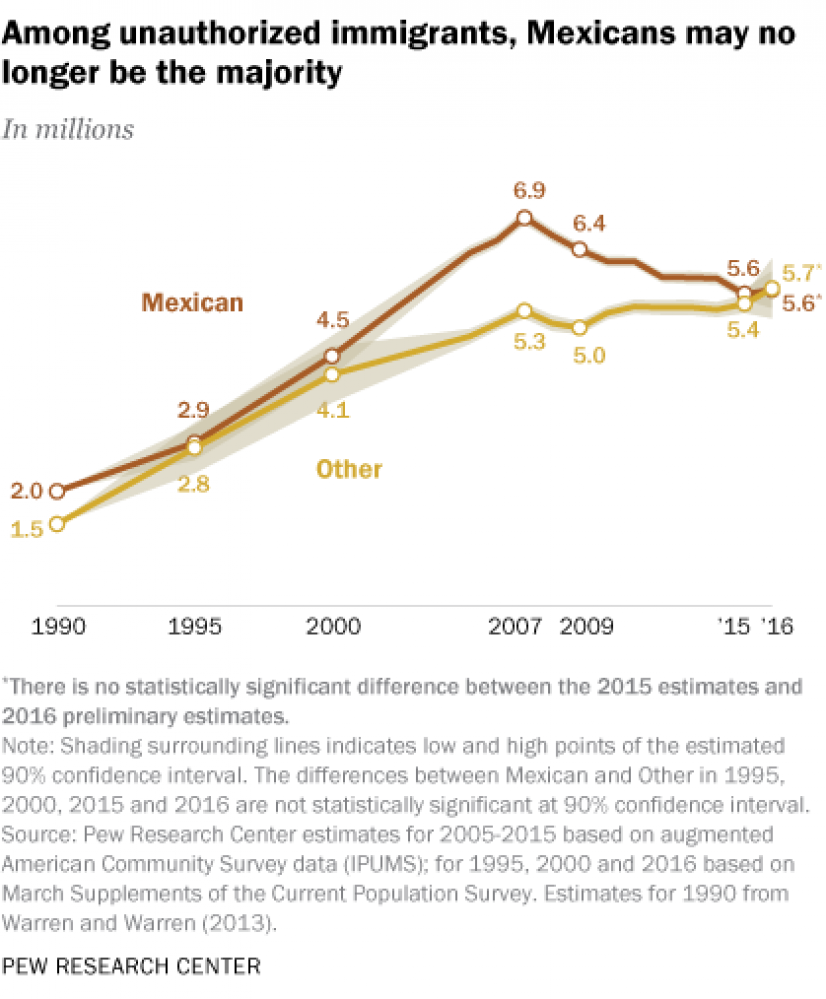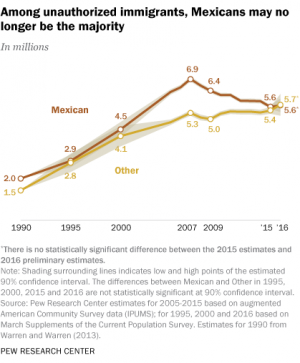How many immigrants are residing illegally in the US today?
Our current estimates from the Pew Research Center estimate about 11 million. They represent about one quarter of all immigrants residing in the US, as there are about 44-45 million immigrants in the US. The number reached as high as about 12.2 million in 2007. Our estimates show a drop of about a million after the recession by 2009, and since then the number has been stable with a little bit of a downward drift in recent years.
How were these numbers calculated?
The basic logic of it is pretty simple. We have data from our censuses and surveys that measure the total number of immigrants in the country. There is a big annual survey that from the US Federal Government called the “American Community Survey” that is used to estimate the total foreign-born population. We make an estimate of how many immigrants are residing legally in the US using principally data on the number of people admitted to the US, and then we basically subtract that estimate from the total foreign-born population number, and the difference is immigrants in the country without authorization. There is a little bit more that goes into it but that is the basic logic of our approach..
How accurate are these numbers?
When we generate the estimate, we put what we call a “margin of error” around it, and it´s based on the idea that the data are from a sample. Our margin of error based only on the variation due to sampling is that the actual number could be 150,000 higher or lower. There are other kinds of potential errors in the estimates including assumptions about the levels of out-migration from the US and coverage of immigrants in the survey. With more extreme assumptions about some of these parameters, the estimate could be as much as million higher and maybe half a million lower, but we consider such estimates as extremely unlikely.
Mexicans no longer make up the majority of irregular immigrants in the US. Could you explain this trend?
First, let me be clear. Mexico is about half the total. We are not sure if it is over half anymore. So we estimate about 5.6 million unauthorized Mexicans in the country.
The next biggest country we estimate is El Salvador at about 700,000, so Mexico is still by far the largest number. What has happened though is that the Mexico number used to be close to 7 million and it has dropped considerably in the last seven years. There are a number of factors for this. The job situation in the US has always been the primary factor drawing Mexicans to the United States. After the great recession we had between 2007-2009, there were many fewer jobs available for unauthorized Mexican immigrants. A lot of the Mexicans in the country at that point went home, particularly those that had recently arrived. The number coming from Mexico has dropped significantly at the same time. Unauthorized immigrant arrivals from Mexico are lower than any time in the last 20 years, firstly due the lack of jobs, and secondly, stepped up enforcement at the border has made it more expensive and difficult for Mexicans to come to the US. In Northern Mexico there is a lot of drug-related violence, so it´s also dangerous for Mexicans not just to cross the border, but just to get to the border. Those are the most important factors.
In addition, Mexico has undergone a tremendous drop in fertility in the last 50 years. Around 1970, the average Mexican woman had seven children and now it has dropped to a little over two. It takes a while demographically for that to work its way through to the population. But now, the age group of the late teens to the early twenties is not as large as 20 years ago, so there are not as many potential migrants either. These factors are all working together.
How could data on irregular migration be improved?
In the US, I think the “big holes” in the estimation process have to do with how good our surveys are. How many people are left out of the surveys? We have been able to make estimates and we are fairly confident of them, but it would be very useful to have better information about survey coverage of both legal and unauthorized immigrants. Another thing that would be very useful is more direct data collection from people who are known to be unauthorized immigrants and information about their characteristics. It doesn’t necessarily have to be a universal survey or one conducted by the US government, but it would be helpful for those of us who are modelling what unauthorized immigrants look like to have more data collected from unauthorized immigrants directly.
Are there any lessons from the US experience for other countries?
The experience I've had is that as we have been able to get better data on the immigrant population and more frequent data collection, demographers have been able to improve the methodology to separately estimate legal and unauthorized migrants. When I started working on this topic, which was almost 40 years ago, there was a very wide range of estimates. People were estimating 6-12 million unauthorized immigrants in the US. Not only is this a very wide range, it was a substantial overstatement —at the time there were probably only two million in the US. So, as we got more data and better data, the estimates have gone up but the range of estimates has narrowed and we finally reached the point where the high estimates and the low estimates are converging as a broad consensus has emerged on the estimates. I think better data on immigrants and better data that researchers can use have improved the discourse of how many immigrants are in the country.


